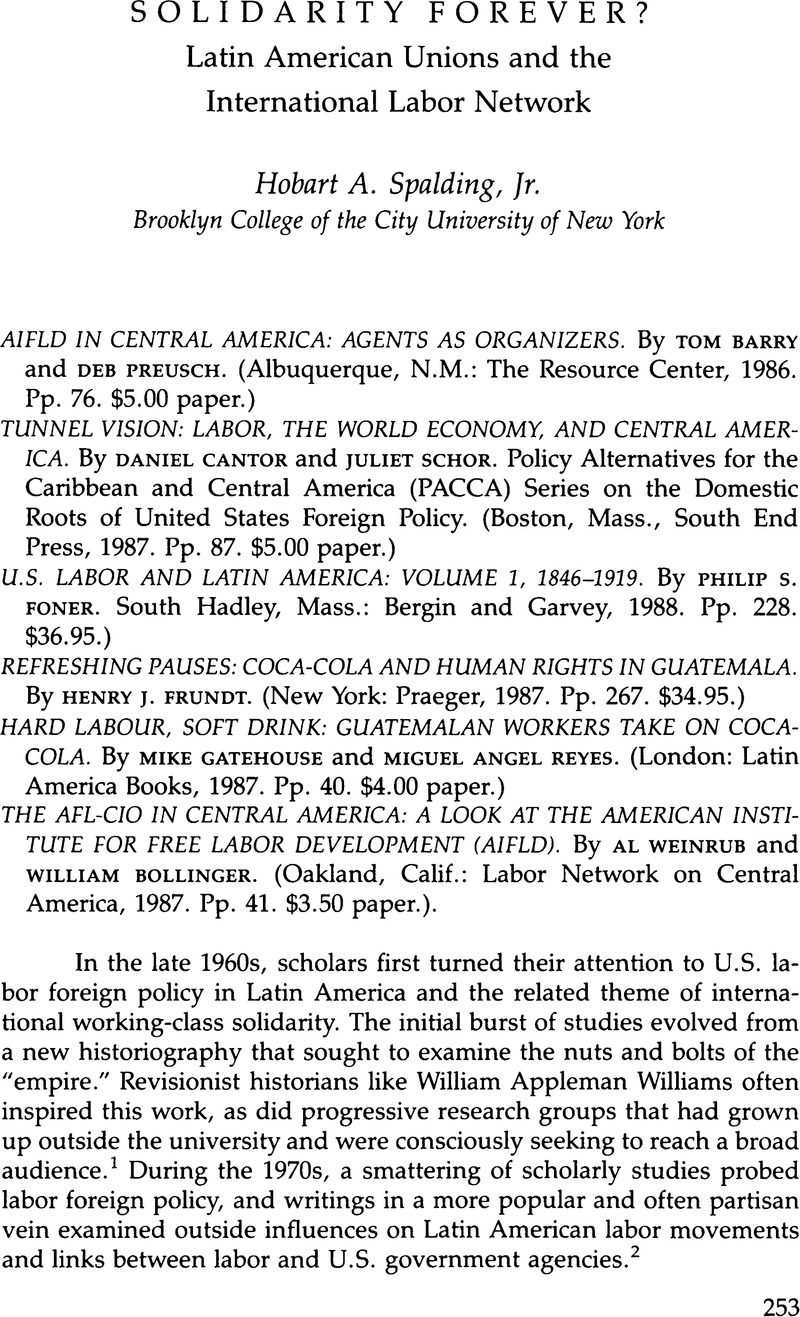Article contents
Solidarity Forever?: Latin American Unions and the International Labor Network
Review products
Published online by Cambridge University Press: 12 October 2022
Abstract

- Type
- Review Essays
- Information
- Copyright
- Copyright © 1989 by the University of Texas Press
References
Notes
1. See, for example, the path-breaking book by then liberal (but now Contra apologist) Ronald Radosh, American Labor and United States Foreign Policy (New York: Random House, 1969); and Henry W. Berger, “Union Diplomacy: America's Labor Foreign Policy in Latin America, 1932–1955,” Ph.D. diss., University of Wisconsin, 1966. Both of the foregoing works were completed under the direction of William Appleman Williams. Early empire studies would include Susanne Bodenheimer, “The AFL-CIO in Latin America: The Dominican Republic, A Case Study,” Viet Report, no. 19 (Sept.–Oct. 1967):17–28; and Sidney Lens, “Labor and the CIA,” The Progressive 31, no. 4 (April 1969). Outstanding work among research groups is that of the North American Congress on Latin America (NACLA) in its Latin America and Empire Report. An exception from the “old left” is George Morris, CIA and American Labor: The Subversion of the AFL-CIO's Foreign Policy (New York: International Publishers, 1967).
2. Examples of more scholarly works include Jeffrey Harrod, Trade Union Foreign Policy: A Study in British and American Trade Union Activities in Jamaica (Garden City, N.Y.: Anchor-Doubleday, 1972); and Hobart A. Spalding, Jr., Organized Labor in Latin America (New York: Harper and Row, 1977), esp. chap. 6. On the more popular level, see Fred Hirsch, An Analysis of Our AFL-CIO Role in Latin America (San Jose, Calif.: Steamfitters, 1974), perhaps the first study made by a labor person; Philip Agee, Inside the Company: CIA Diary (Harmondsworth, Eng.: Penguin, 1975); NACLA, “AIFLD Losing Its Grip” in Argentina in the Hour of the Furnaces (New York: NACLA, 1975), 56–76; or these articles from Counterspy: “CIA Target: Labor,” vol. 2, no. 1 (Fall 1974):26–47; and “CIA Labor Operations in Latin America,” vol. 2, no. 2 (Winter 1975):30–59.
3. For more on AIFLD, see Hobart A. Spalding, Jr., “U.S. Labour Intervention in Latin America: The Case of the American Institute for Free Labor Development,” in Trade Unions and the New Industrialization of the Third World, edited by Roger Southall (London, Ottawa, and Pittsburgh: Zed Press, Ottawa University Press, and University of Pittsburgh Press, 1988), 259–86. For very recent material, see “Unions Look South,” “AIFLD in Action,” and “AIFLD Amok,” NACLA Report on the Americas 22, no. 3 (May–June 1988):14–27, 37–39.
4. See Jack Haberle, “New Attack on AIFLD Rebutted,” AIFLD Briefs, 8 Oct. 1987.
5. A sampling of publications would include National Labor Committee in Support of Democracy and Human Rights in El Salvador, “El Salvador: Labor, Terror, and Peace” (New York: National Labor Committee in Support of Democracy and Human Rights in El Salvador, 1983); William C. Doherty, Jr., “Nicaragua, A Revolution Betrayed: Free Labor Persecuted,” Free Trade Union News 39 (Mar. 1984):1–3, 8; “The Sandinistas and the Workers: The Betrayal Continues,” in Sandinista Repression of Nicaraguan Trade Unions (Washington, D.C.: AIFLD, 1985), 1–10; U.S. Labor Lawyers' Delegation to Nicaragua, Are Nicaragua's Trade Unions Free?: A Response to the American Institute for Free Labor Development (AFL-CIO) Report, “Nicaragua, A Revolution Betrayed: Free Labor Persecuted” (New York: National Lawyers Guild, 1985); AIFLD, U.S. Labor's Single Standard on Dictatorships (Washington, D.C.: AIFLD, 1985); AIFLD, Sandinista Deception Reaffirmed: Nicaragua Coverup on Trade Union Repression (Washington, D.C: AIFLD, 1985); James McCargar, El Salvador and Nicaragua: The AFL-CIO View on the Controversy (Washington, D.C.: AFL-CIO, 1985); and National Labor Committee in Support of Democracy and Human Rights in El Salvador, The Search for Peace in Central America (New York: National Labor Committee in Support of Democracy and Human Rights in El Salvador, 1985). The latest pamphlets in the war include these items: Americas Watch, Labor Rights in El Salvador (New York: Americas Watch, 1988); the AFL-CIO and AIFLD response of 10 June 1988 entitled “A Critique of the Americas Watch Report on Labor Rights in El Salvador,” mimeo; and finally, the Americas Watch response, “Americas Watch Critique of AIFLD Critique on ‘Labor Rights in El Salvador,‘” mimeo, 1988.
6. For a good summary and update of the contemporary debate within the labor movement, see David Slaney, “Solidarity and Self-Interest,” NACLA Report on the Americas 22, no. 3 (May–June 1988):28–36, 39–40.
7. See the unsigned review entitled “Foreign Policy: Differences or Distortions,” The Bulletin of the Department of International Affairs, AFL-CIO 3, no. 4 (Apr. 1988):6–7.
8. Miguel Angel Reyes, “La derrota de una transnacional: STECSA contra Coca Cola,” mimeo, Guatemala City, 1986.
9. See, for example, Jane Slaughter, “Auto Workers Find Companies' Drive for ‘Flexibility’ and ‘Teamwork’ Is International,” Labor Notes, no. 109 (Apr. 1988):7, 11. This article discusses a conference partly sponsored by Brazilian unions that brought together autoworkers from eleven countries. It notes that Brazilian autoworkers are linked to British unions by computer, making possible “instant” solidarity actions or communications. This network was used in a recent strike against British Ford.
- 3
- Cited by




